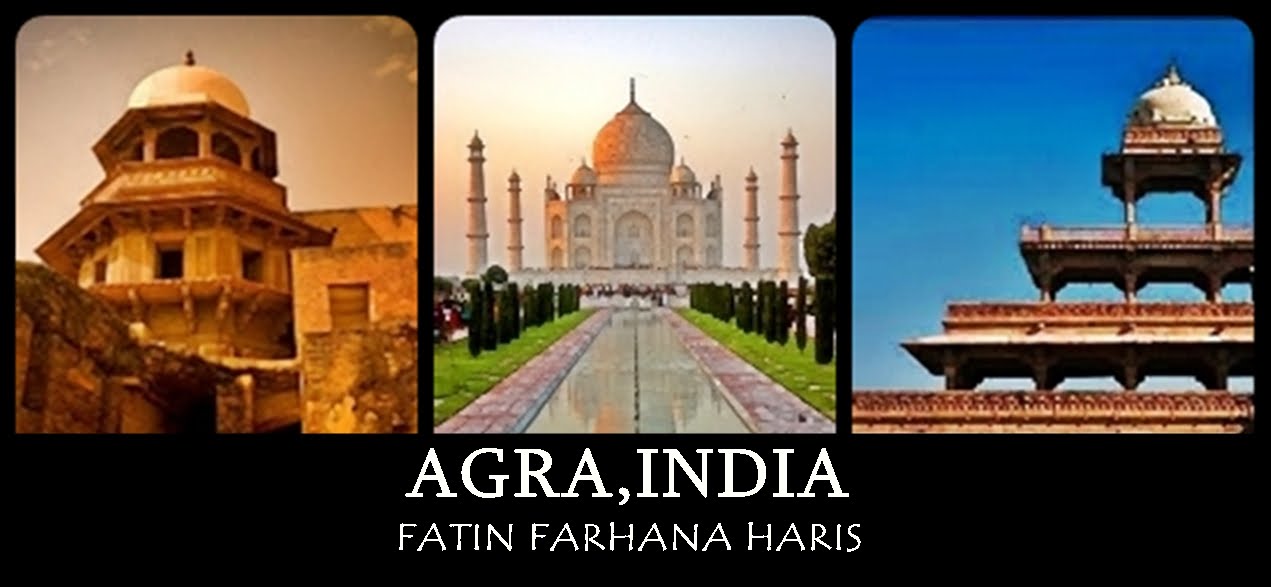AGRA
- Agra city is an important tourist place in terms of historical and architectural attractions in its precincts.
- Location is in Uttar Pradesh State,India
- Estimated population is 1.4 millions
- Area Agra is 4082 sq.km.
- The winter in Agra was 4.20 C 31.70 C
- Altitude of Agra is 169 Meters above sea level
- Language spoken in agra is Hindi,Urdu and English
- The temperature during summer- 21.90 °C - 45.00 °C
- Rainfall is average yearly 66 cm.
Agra Fort
- Agra Fort is a UNESCO World Heritage site. The fort is also known as 'Lal Qila', Fort Rouge and Red Fort of Agra.
- Agra fort was originally a brick fort and the Chauhan Rajputs held it. It was mentioned for the first time in 1080 AD when a Ghaznavide force captured it.
- Sikandar Lodi was the first Sultan of Delhi, who shifted to Agra and lived in the fort.
- The great Mughal Emperors, Babur, Humayun, Akbar, Jehangir, Shah Jahan and Aurangzeb lived here and the country was governed from here.
- According to Abul Fazl, a historian during Akbar's reign, this brick fort was in a ruined condition and was known as Badalgarh.
- Akbar had it rebuilt with red sandstone. Some 1,444,000 builders worked on it for eight years, completing it in 1573.
- It contained the largest state treasury and mint. It was visited by foreign ambassadors, travelers and the highest dignitaries, who are an integral part of the history of India.
- The fort can be more accurately described as a walled palatial city.
- The fort has a semi-circular plan, its chord lying parallel to the Yamuna River and stretches for almost 2.5 km.
- The walls of the Fort are seventy feet high.
- It consists of a wall built in red sandstone and several buildings inside. It has 4 gates on four sides, two of which are known as the Delhi Gate and the Amar Singh Gate. You can only enter the fort via the Amar Singh Gate.
- Some of the most historically interesting mix of Hindu and Islamic architecture can be seen here. The Islamic decorations here feature forbidden images of living creatures - dragons, elephants and birds, instead of the usual patterns and calligraphy seen in Islamic surface decoration.
- The Agra Fort plays a key role in the Sherlock Holmes mystery, 'The Sign of the Four' by Sir Arthur Conan Doyle.
- The Agra Fort has won the Aga Khan Award for Architecture in the year 2004 and Indian Post issued a stamp to commemorate this prestigious award on 28 November, 2004.
- The Agra Fort was featured in the music video for Habibi Da, a hit song of Egyptian pop star Hisham Abbas
Fatehpur Sikri
- Being the first planned Mughal city.
- Its immaculately preserved fort and palaces that were abandoned by Emperor Akbar due to a shortage of water supply for the city.
- Being recognised as a World Heritage Site (UNESCO).
- Akbar's secular vision and style of governance is in full dislay at Fatehpur Sikri. Various religions and architectural styles are visible throughout the royal complex.
- Many childless women of all castes and religions come to visit the Tomb of Sufi saint Salim Chisti to pray for his blessings.
- The city, far away from the Yamuna River, was abandoned due to shortage of water.
- Fatehpur sikri was built during 6th century
- It was built by Akhbar the great.
- Fatehpur Sikri was located at Uttar Pradesh
- Language spoken in Fatehpur Sikri was Hindi and English
- The best time to visit was on October to March
- There are number of buildings in Fatehpur Sikri built mostly with red stone. The compound has small palaces which were built for specific purposes.
- Naubat Khana: it is the drum house situated near the entrance where important arrivals are announced.
- Diwan-i-Am: it is the hall for public audience which is found in most of the Mughal buildings with large open space.
- Diwan-i-Khas: it is hall of private audience and it is famous for its decorated pillar consisting of 36 elegantly carved brackets made in Gujarati style.
- Marium-uz-Zamani: this is built around courtyard for complete privacy made in Gujarati style.
- Panch Mahal: it is a five storied impressive structure which has 176 carved columns on the ground floor. It is the most fascinating building in Fatehpur Sikri.
- Buland Darwaza: it is a huge gateway to Jama Masjid which is a fantastic piece of architecture and it is termed as “gate of magnificence”.
- Jama Masjid: it is a mosque where Muslims follow prayers everyday.
- Tomb of Salim Chisti: it is the white marble encased tomb of Salim Chisti who was Sufi saint and also the person who was very honored by the great Akbar.
Taj Mahal
| |||

jujujuujujujujujujujujuju muy interesante
ReplyDeleteVIVA WILLYREEEX
Very good and interesting facts
ReplyDeleteVery good and interesting facts
ReplyDeleteSource: Agra Times
ReplyDeleteI read your blog. Such a great information.it has extend my knowledge on India and its various tourist destinations.
ReplyDeleteSame Day Agra Tour Bya Car